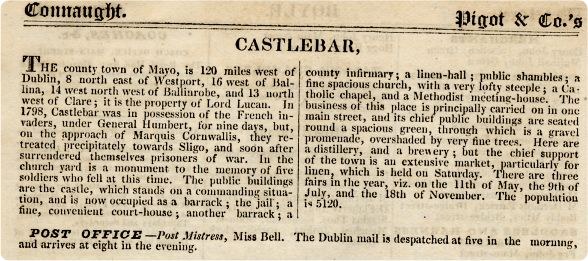|
From Castlebar - County Mayo - Nostalgia
Early history. Castlebar (Caisleáin a Bharraigh) is situated at the mouth of Lough Lannagh on the Castlebar River (An TSiúir) in the barony of Carra. The early inhabitants of the region were hunter-gatherers. There is evidence of these peoples in the number of ring forts and crannógs (dating back to Iron Age times) situated right around the town. The parish name is Aglish (Eaglais Clann Cuain) translated the church of Clan Cuain. Slight remains of an early Christian church lie within Castlebar Old Cemetery which gives us the parish name. The Clan Cuain were an ancient Gaelic family and part of the tribe known as Na Fir Tíre or Fir Siúire).The surname Quinn) is derived from Clan Cuain. There are at least two crannógs within Lough Lannagh. The largest of these was Boyd's Island. (Named after a medical family who lived in Mount Gordon House.) During the C12th a member of the Mulroney clan (kinsman of Donal O'Quinn) was slain "in his own mansion on Claenloch in Clan Chuain." This Claenloch was the Crannog mentioned above The Arrival of the Binghams (Lucans). During the second invasion of Ireland (1585) the Tánaiste (Leader) of the Bourkes Edmond was hanged following a mock trial at Donomona Castle and his estate confiscated by George Bingham, Governor of Connaught. In 1613 King James 1st of England granted a Royal Charter of Incorporation to John Bingham, a brother of George. This gave the town a Portreeve (Mayor) and a 15-member corporation &the right to elect 2 members to the Irish House of Parliament. In 1691 the town being the main British Outpost in Connaught next to Galway was made a Garrison town. Over the years several regiments were stationed here including Welsh & Scottish Fencibles, the 69th Regiment and the Connaught Rangers. Barracks built here in 1834 on site of an earlier garrison. The first Earl, Charles, was created Baron in 1776 and Earl in 1795. The residence of the Lucan/Bingham families was Lawn House, now a Secondary School. The Third Earl of Lucan was notorious in how he treated his tenants, so much so that even the British media referred to him as "The Great Exterminator". He was responsible along with his Crowbar Brigade for the mass evictions of tenants. Many died of starvation in the locality & thousands more emigrated. The destitute tenants had nowhere to go for help but to the Workhouse, which he helped to found in 1838. The workhouse was opened in 1842 and by 1847 he, as chairman of the Board of Guardians was instrumental in closing, declaring the Board bankrupt. A Bridewell was built next to The Green in 1786. It was here that "The Fighting Fitzgerald" of Turlough Park House executed for the murder of Randall Mc Donnell in 1786 Beside this is the grave of John Moore, from Moorehall, who was elected the First president of Connaught following the capture of Castlebar by the Franco-Irish forces. He died in captivity awaiting deportation in Waterford Harbour in 1799. His remains were re-interred here in 1961. The ceremony was attended by the President Eamonn De Valera and was given the full honours of Church and State. Davitt & The Land League The Mayo Land League was founded by Michael Davitt in Daly's Hotel, on 16 August 1879. There is a tablet on the wall of the Hotel, which reads: "In this house the National Land League was founded on 16th, 1879, by Michael Davitt, without whose life and work we would not own our land to day. To his memory and the memory of all those who helped in the Land War which our people, under his leadership, fought and won, the Land Project of 1949 is dedicated, on behalf of the Irish people, by the Government of Ireland, August 16th, 1949." The Linen Industry. Following the Battle of the Diamond in Northern Ireland planters came to the locality in the 1770s to develop the flax growing and linen industries .Newantrim & Linenhall streets take their names from this era in our history. The Linenhall was the clearing-house for the linen industry and was constructed in 1790. Newantrim Street was previously known as Shruffane, a name still used by many locals. This area of town is one of the oldest residential parts in the town and was cradle to the Castlebar Mitchels Gaelic football team and of republican Castlebar. The backbone of the county teams of the 1930's came from here. In Tucker Street stood "The Rooney Hall" (William Rooney one of the founders of the United Irishman and Cumann na Gael.) Rooney and Maud Gonne Mc Bride visited the town to celebrate the centenary of the 1798 rebellion.
© Copyright 2014 by Castlebar - County Mayo - |
